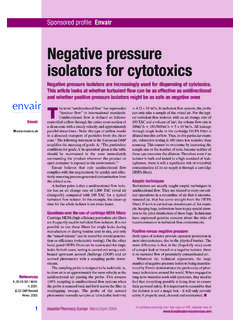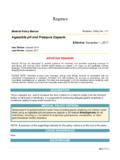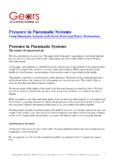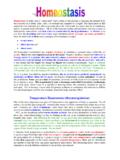Transcription of Rosemount 2024 Differential Pressure Transmitter YZcj ...
1 Manual 00809-0100-4592, Rev BAMarch 2007 Rosemount 2024 Differential Pressure TransmitterProduct DiscontinuedReference Manual 00809-0100-4592, Rev BAMarch 2007 Rosemount 2024 Differential Pressure Transmitter .. Rosemount , the Rosemount logotype and Coplanar are registered trademarks of Emerson Process and Teflon are registered trademarks of du Pont de Nemours & C-276 and Hastelloy C are registered trademarks of Cabot this manual before working with the product. For personal and system safety, and for optimum product performance, make sure you thoroughly understand the contents before installing, using, or maintaining this equipment service needs outside the United States, contact the nearest Rosemount the United States, the Rosemount National Response Center is at your service 24 hours a day, and is a single-point contact for all Rosemount equipment service needs. If at any time you are not sure what to do, you have a question about using the product, or you have a service or support request, call the center toll free at 1-800-654-RSMT (7768).
2 This contact is your fastest link to quick and complete answers about any Rosemount Group product or products described in this document are NOT designed for nuclear applications. Using non-nuclear qualified products in applications that require nuclear-qualified hardware or products may cause inaccurate readings. For information on Rosemount nuclear-qualified products, contact your local Rosemount Sales Manual 00809-0100-4592, Rev BAMarch 2007 TOC-1 Rosemount 2024 SECTION 1 InstallationIntroduction..1-1 Before Installation..1-1 Mounting..1-1 Impulse Piping ..1-3 Wiring ..1-44 20 mA dc Output Wiring ..1-41 5 V dc Output Wiring..1-5 Liquid Level Measurement ..1-6 Open Vessels..1-6 Closed Vessels..1-6 SECTION 2 CalibrationCalibration Limits ..2-1 Zero and Span Adjustments..2-1 Recalibration Steps ..2-2 SECTION 3 Theory of OperationIntroduction..3-1 Voltage-Controlled Oscillator (VCO) ..3-2 Demodulator.
3 3-2 Current Inverter ..3-2 VCO Control Amplifier ..3-3 Current Detector (Output Code A) ..3-3 Current Control Amplifier (Output Code A)..3-3 Current Limiter (Output Code A) ..3-3 Voltage Regulator (OUTPUT CODE A) ..3-3 Temperature Compensation..3-3 SECTION 4 TroubleshootingGeneral..4-1 Wiring ..4-1 Impulse Piping..4-1 Return Of Materials ..4-1 SECTION 5 SpecificationsFunctional Specifications ..5-1 Performance Specifications ..5-3 Physical Specifications..5-4 SECTION 6 Reference DataOrdering Information ..6-1 Dimensional Drawings ..6-2 Spare Parts List ..6-3 Table of ContentsReference Manual00809-0100-4592, Rev BAMarch 2007 Rosemount 2024 TOC-2 Reference Manual 00809-0100-4592, Rev BAMarch 2007 Rosemount 1 InstallationINTRODUCTIONThe Rosemount 2024 is a compact and lightweight Differential Pressure Transmitter for applications requiring direct mounting and repair by replacement. The Rosemount 2024 is available with outputs of 4 20 mA (Code A) or 1 5 V dc (Code M Low Power) in ranges of 0 50/250 inH2O (0 kPa) or 0 200/1,000 inH2O (0 kPa).
4 This section includes instructions for mounting Transmitter and wiring the terminals, as well as special instructions for liquid level INSTALLATIONThe accuracy of Pressure measurement depends to a great extent on proper installation of the Transmitter and impulse piping. For flow measurement, proper installation of the primary measurement element is also critical. Because of economic and process-related considerations, Pressure transmitters often must be installed in harsh environments. Within these environments, transmitters should be placed so as to minimize vibration, shock, and the effects of temperature Rosemount 2024 Differential Pressure Transmitter may be directly mounted at the point of measurement or to a manifold. It may also be mounted by means of a mounting connections are 1/4 18 NPT on the Transmitter flange. 1/2 14 NPT process connections are supplied by use of flange adapter unions.
5 The adapters allow users to disconnect the Transmitter from the process simply be removing the adapter bolts. The process connections are on 21/8-in. (54-mm) centers to allow direct mounting to orifice flanges; by rotating the adapters, however, connection centers of 2 in. (51 mm) or 21/4-in. (57 mm) also may be obtained. NOTEAll four flange bolts must be in place for a tight seal. The two hex head flange-holding bolts are not Pressure ensure a tight seal on the mounting adapters or manifold, first finger-tighten the bolts and then wrench-tighten the first bolt to approximately 400 50 in-lb. Then in a cross pattern, wrench-tighten the second bolt to approximately 400 50 assembling flange adapters to the Transmitter , the correct Rosemount O-ring must be used. Failure to use the correct O-ring can lead to process leakage which may result in a hazardous condition. Use only the O-ring specified for use with the Rosemount Model, as indicated in the spare parts list, Figure Manual00809-0100-4592, Rev BAMarch 2007 Rosemount 20241-2 The Transmitter may be rotated for mounting convenience.
6 As long as the Transmitter is mounted so that both isolating diaphragms are at the same elevation, this rotation will not cause zero shift. If the isolating diaphragms are not at the same elevations, the Transmitter should be rezeroed to cancel the liquid head effect caused by the difference in height of the process connections. Rezero the Transmitter after mounting to compensate for any mounting provided with some manifolds for mounting the Transmitter to the manifold may not be long enough to fully thread into the Rosemount 2024. Because of this, all bolts required to properly mount the Rosemount 2024 are supplied with the Transmitter . Refer to Figure 1-1 to find the correct bolt length for the desired mounting MOUNTINGMOUNTING WITH ADAPTER UNION3 VALVE MANIFOLD ( ) ( ) ( ) ( )Figure 1-1. Required Mounting are in inches (millimeters).Reference Manual 00809-0100-4592, Rev BAMarch 20071-3 Rosemount 2024 IMPULSE PIPINGThe best location for the Transmitter in relation to the process pipe depends on the process material.
7 Consider the following general rules in determining Transmitter location: Ensure that corrosive or hot process material does not come in contact with the Transmitter . Ensure that sediment does not build up in the impulse piping. Ensure that the liquid head remains balanced on both legs of the impulse piping. Keep impulse piping as short as possible. Avoid ambient temperature gradients and fluctuations. Weatherize impulse piping to prevent freezing of process in impulse measurement conditions call for different piping configurations. For liquid Pressure and Differential Pressure service, place taps to the sides of the line to prevent sediment deposits, and mount the Transmitter beside or below these taps so gases can vent into the process line. For gas Pressure and Differential Pressure service, place taps in the top or side of the line, and mount the Transmitter beside or above the taps so the liquid will drain into the process line.
8 For the steam Pressure and Differential Pressure service, place the taps to the side of the line, and mount the Transmitter below to ensure that the impulse piping stays filled with condensate. See Figure 1-2 for diagram of these arrangements. In steam or other elevated temperature services, it is important that the operating temperatures not exceed the Transmitter s limit. Refer to Temperature Limits on page steam service, lines should be filled with water to prevent live steam from contacting the Transmitter . Condensate chambers are not needed, since the volumetric displacement of the Transmitter is negligible. The piping between the process and the Transmitter must transfer the Pressure at the process taps to the Transmitter . In this Pressure transfer, there are five possible sources of error: leaks, friction loss (particularly if purging is used), trapped gas in a liquid line, liquid in a gas line, and temperature-induced density variation between the legs.
9 The last three factors all involve head minimize the potential for error, observe the following precautions: Make impulse piping as short as possible. Slope piping at least one inch per foot (8 cm per meter) up toward the process connection for liquid and steam. Slope piping at least one inch per foot (8 cm per meter) down toward the process connection for gas. Avoid high upoints in liquid lines and low points in gas lines. Keep both impulse legs at the same temperature. Use impulse piping of sufficient diameter to avoid friction effects. Drain all liquid/condensate from gas piping legs. Vent all gas from the liquid piping legs. Fill both piping legs to the same level when using a sealing fluid. Avoid purging through the Transmitter . When purging, make the purge connection close to the process taps, and purge through equal lengths of the same size Manual00809-0100-4592, Rev BAMarch 2007 Rosemount 20241-4 WIRINGW iring for the Rosemount 2024 depends on the output of the Transmitter , but some general information is common to the procedures for wiring both outputs.
10 The signal terminals are located in a separate compartment of the electronics housing. This compartment also contains terminals for test equipment or remote meter connection. To wire the connections, remove the cover on the side marked Terminals on the nameplate. For transmitters with 4 20 mA dc outputs (Code A), use the following instructions. For transmitters with 1 5V dc outputs (Code M-Low Power), skip to the heading: 1 5 V dc Output 20 MA DC OUTPUT WIRINGC onnect power to the (+) SIGNAL and ( ) COMMON terminals. Figure 1-3 shows the terminal locations. The negative COMMON terminal is common to both the positive signal and the positive test test connections have the same 4 20 mA dc signal as the signal connections. Test equipment or a remote meter can be connected across the positive TEST terminal and the COMMON terminal. No additional wiring is Tee for Steam Service for Sealing FluidFigure 1-2.















![Untitled-1 [cbperformance.net]](/cache/preview/e/5/f/7/b/1/6/5/thumb-e5f7b165dd01480669456e1777756b9f.jpg)

